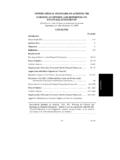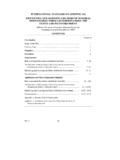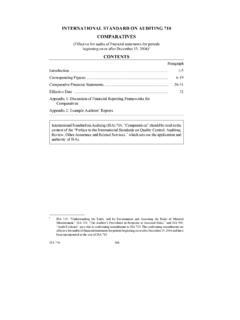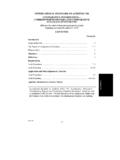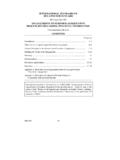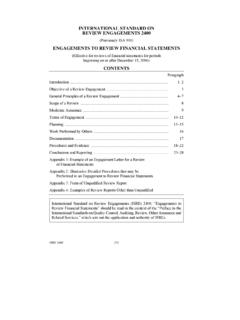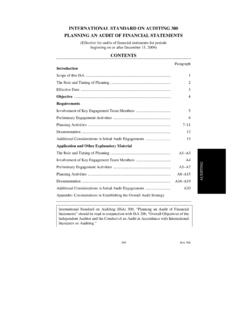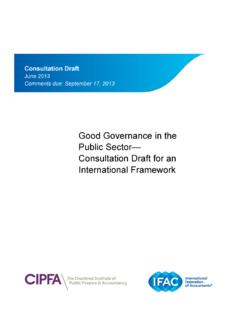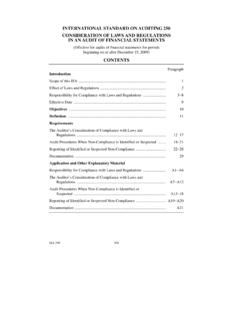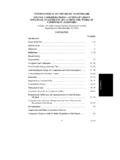Transcription of This Consultation Paper, , was
1 This Consultation Paper, A Framework for Audit Quality, was developed and approved by the International Auditing and Assurance Standards Board (IAASB). The IAASB develops auditing and assurance standards and guidance for use by all professional accountants under a shared standard-setting process involving the Public Interest Oversight Board, which oversees the activities of the IAASB, and the IAASB Consultative Advisory Group, which provides public interest input into the development of the standards and guidance. The objective of the IAASB is to serve the public interest by setting high-quality auditing, assurance, and other related standards and by facilitating the convergence of international and national auditing and assurance standards, thereby enhancing the quality and consistency of practice throughout the world and strengthening public confidence in the global auditing and assurance profession.
2 The structures and processes that support the operations of the IAASB are facilitated by the International Federation of Accountants (IFAC). Copyright January 2013 by the International Federation of Accountants (IFAC). For copyright, trademark, and permissions information, please see page 70. REQUEST FOR COMMENTS. Comments are requested by May 15, 2013. Respondents are asked to submit their comments electronically through the IAASB website, using the Submit a Comment link. Please submit comments in both a PDF and Word file. Also, please note that first-time users must register to use this feature. All comments will be considered a matter of public record and will ultimately be posted on the website.
3 This publication may be downloaded free of charge from the IAASB website: The approved text is published in the English language. The IAASB seeks comments from all stakeholders on the Consultation paper, A Framework for Audit Quality (the Framework). In particular, it is seeking views on whether the Framework is clear, comprehensive and useful. The IAASB believes the development of the Framework to be in the public interest as it aims to contribute to improving audit quality. It describes a number of factors (inputs, outputs, interactions, and contextual factors) that contribute to increasing the likelihood of quality audits being consistently performed and encourages audit firms and other stakeholders to challenge themselves about whether there is more that they can do to increase audit quality in their particular environments.
4 While the primary responsibility for performing quality audits rests with auditors, audit quality is best achieved in an environment where there is support from other participants in the financial reporting supply chain. In developing the Framework, the IAASB has identified, with the input of stakeholders, a number of areas for consideration by both auditors and other participants in the financial reporting supply chain that may benefit audit quality on a global basis. These are described as Areas to Explore and have been outlined in Appendix 1 of the Framework. The IAASB welcomes views on whether international collaboration in these areas would be fruitful and whether there are other areas that need to be explored internationally to improve audit quality.
5 The IAASB seeks comments in response to the following questions: 1. Does the Framework cover all of the areas of audit quality that you would expect? If not, what else should be included? 2. Does the Framework reflect the appropriate balance in the responsibility for audit quality between the auditor (engagement team and firm), the entity (management and those charged with governance), and other stakeholders? If not, which areas of the Framework should be revised and how? 3. How do you intend to use the Framework? Are there changes that need to be made to the form or content of the Framework to maximize its value to you?
6 4. What are your views on the suggested Areas to Explore? Which, if any, should be given priority and by whom? Are there additional Areas to Explore? Stakeholder Survey To assist with the development of the Framework, in 2011 the IAASB undertook a survey of stakeholders in nine countries (Australia, Canada, Germany, Japan, Netherlands, New Zealand, South Africa, UK, and US) as well as some members of the IAASB's Consultative Advisory Group (CAG). Stakeholders were provided with a list of possible factors that they might take into account in forming a view on the likely quality of an audit and were asked to indicate whether the factors were (a) important, (b).
7 Less important, or (c) not important. They were also requested to add other factors not on the list and provide comments. 169 responses to the survey were received. The results demonstrate that perceptions of audit quality vary among stakeholders. This, in itself, is not surprising as the level of their direct involvement in, and access to information relevant to, an audit varies greatly. A summary of the key factors that key stakeholder groups take into account in forming a view on audit quality is included in Appendix 2. Detailed discussion of the survey results is available at: THIS PAGE HAS BEEN INTENTIONALLY LEFT BLANK.
8 A FRAMEWORK FOR AUDIT QUALITY. Audit Quality Draft Framework IAASB Main Agenda (December 2012). The IAASB's Vision for the Framework The objectives of the Framework for Audit Quality include: Raising awareness of the key elements of audit quality;. Encouraging key stakeholders to explore ways to improve audit quality; and Facilitating greater dialogue between key stakeholders on the topic. The IAASB expects that the Framework will generate discussion, and positive actions to achieve a continual improvement to audit quality. Auditors are required to comply with relevant auditing standards and standards of quality control within audit firms, as well as ethics and other regulatory requirements.
9 The Framework is not a substitute for such standards, nor does it establish additional standards or provide procedural requirements for the performance of audit engagements. 9. Foreword from the IAASB Chairman Recent financial conditions have highlighted the critical importance of credible, high-quality financial reporting in all sectors of the world economy, including the capital markets, small companies, not-for-profit and government organizations. They have also reinforced the need, in the public interest, for continual improvement to audit quality. The term audit quality is frequently used in debates among stakeholders, in communications of regulators, standard setters, audit firms and others, and in research and policy setting.
10 Audit quality is a complex subject and there is no definition or analysis of it that has achieved universal recognition. In the IAASB's view, a quality audit is likely to be achieved when the auditor's opinion on the financial statements can be relied upon as it was based on sufficient appropriate audit evidence obtained by an engagement team that: Exhibited appropriate values, ethics and attitudes;. Was sufficiently knowledgeable and experienced and had sufficient time allocated to perform the audit work;. Applied a rigorous audit process and quality control procedures;. Provided valuable and timely reports; and Interacted appropriately with a variety of different stakeholders.
